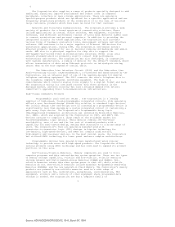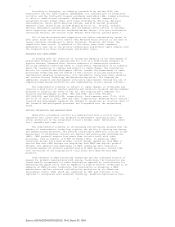AMD 1993 Annual Report Download - page 18
Download and view the complete annual report
Please find page 18 of the 1993 AMD annual report below. You can navigate through the pages in the report by either clicking on the pages listed below, or by using the keyword search tool below to find specific information within the annual report.-
 1
1 -
 2
2 -
 3
3 -
 4
4 -
 5
5 -
 6
6 -
 7
7 -
 8
8 -
 9
9 -
 10
10 -
 11
11 -
 12
12 -
 13
13 -
 14
14 -
 15
15 -
 16
16 -
 17
17 -
 18
18 -
 19
19 -
 20
20 -
 21
21 -
 22
22 -
 23
23 -
 24
24 -
 25
25 -
 26
26 -
 27
27 -
 28
28 -
 29
29 -
 30
30 -
 31
31 -
 32
32 -
 33
33 -
 34
34 -
 35
35 -
 36
36 -
 37
37 -
 38
38 -
 39
39 -
 40
40 -
 41
41 -
 42
42 -
 43
43 -
 44
44 -
 45
45 -
 46
46 -
 47
47 -
 48
48 -
 49
49 -
 50
50 -
 51
51 -
 52
52 -
 53
53 -
 54
54 -
 55
55 -
 56
56 -
 57
57 -
 58
58 -
 59
59 -
 60
60 -
 61
61 -
 62
62 -
 63
63 -
 64
64 -
 65
65 -
 66
66 -
 67
67 -
 68
68 -
 69
69 -
 70
70 -
 71
71 -
 72
72 -
 73
73 -
 74
74 -
 75
75 -
 76
76 -
 77
77 -
 78
78 -
 79
79 -
 80
80 -
 81
81 -
 82
82 -
 83
83 -
 84
84 -
 85
85 -
 86
86 -
 87
87 -
 88
88 -
 89
89 -
 90
90 -
 91
91 -
 92
92 -
 93
93 -
 94
94 -
 95
95 -
 96
96 -
 97
97 -
 98
98 -
 99
99 -
 100
100 -
 101
101 -
 102
102 -
 103
103 -
 104
104 -
 105
105 -
 106
106 -
 107
107 -
 108
108 -
 109
109 -
 110
110 -
 111
111 -
 112
112 -
 113
113 -
 114
114 -
 115
115 -
 116
116 -
 117
117 -
 118
118 -
 119
119 -
 120
120 -
 121
121 -
 122
122 -
 123
123 -
 124
124 -
 125
125 -
 126
126 -
 127
127 -
 128
128 -
 129
129 -
 130
130 -
 131
131 -
 132
132 -
 133
133 -
 134
134 -
 135
135 -
 136
136 -
 137
137 -
 138
138 -
 139
139 -
 140
140 -
 141
141 -
 142
142 -
 143
143 -
 144
144 -
 145
145 -
 146
146 -
 147
147 -
 148
148 -
 149
149 -
 150
150 -
 151
151 -
 152
152 -
 153
153 -
 154
154 -
 155
155 -
 156
156 -
 157
157 -
 158
158 -
 159
159 -
 160
160 -
 161
161 -
 162
162 -
 163
163 -
 164
164 -
 165
165 -
 166
166 -
 167
167 -
 168
168 -
 169
169 -
 170
170 -
 171
171 -
 172
172 -
 173
173 -
 174
174 -
 175
175 -
 176
176 -
 177
177 -
 178
178 -
 179
179 -
 180
180 -
 181
181 -
 182
182 -
 183
183 -
 184
184 -
 185
185 -
 186
186 -
 187
187 -
 188
188 -
 189
189 -
 190
190 -
 191
191 -
 192
192 -
 193
193 -
 194
194 -
 195
195 -
 196
196 -
 197
197 -
 198
198 -
 199
199 -
 200
200 -
 201
201 -
 202
202 -
 203
203 -
 204
204 -
 205
205 -
 206
206 -
 207
207 -
 208
208 -
 209
209 -
 210
210 -
 211
211 -
 212
212 -
 213
213 -
 214
214 -
 215
215 -
 216
216 -
 217
217 -
 218
218 -
 219
219 -
 220
220 -
 221
221 -
 222
222 -
 223
223 -
 224
224 -
 225
225 -
 226
226 -
 227
227 -
 228
228 -
 229
229 -
 230
230 -
 231
231 -
 232
232 -
 233
233 -
 234
234 -
 235
235 -
 236
236 -
 237
237 -
 238
238 -
 239
239 -
 240
240 -
 241
241 -
 242
242 -
 243
243 -
 244
244 -
 245
245 -
 246
246 -
 247
247 -
 248
248 -
 249
249 -
 250
250 -
 251
251 -
 252
252 -
 253
253 -
 254
254 -
 255
255 -
 256
256 -
 257
257 -
 258
258 -
 259
259 -
 260
260 -
 261
261 -
 262
262 -
 263
263 -
 264
264 -
 265
265 -
 266
266 -
 267
267 -
 268
268 -
 269
269 -
 270
270 -
 271
271 -
 272
272 -
 273
273 -
 274
274 -
 275
275 -
 276
276 -
 277
277 -
 278
278 -
 279
279 -
 280
280 -
 281
281 -
 282
282 -
 283
283 -
 284
284 -
 285
285 -
 286
286 -
 287
287 -
 288
288 -
 289
289 -
 290
290 -
 291
291 -
 292
292 -
 293
293 -
 294
294 -
 295
295 -
 296
296 -
 297
297 -
 298
298 -
 299
299 -
 300
300 -
 301
301 -
 302
302 -
 303
303 -
 304
304 -
 305
305 -
 306
306 -
 307
307 -
 308
308 -
 309
309 -
 310
310 -
 311
311 -
 312
312 -
 313
313 -
 314
314 -
 315
315 -
 316
316 -
 317
317 -
 318
318 -
 319
319 -
 320
320 -
 321
321 -
 322
322 -
 323
323 -
 324
324 -
 325
325 -
 326
326 -
 327
327 -
 328
328 -
 329
329 -
 330
330 -
 331
331 -
 332
332 -
 333
333 -
 334
334 -
 335
335 -
 336
336 -
 337
337 -
 338
338 -
 339
339 -
 340
340 -
 341
341 -
 342
342 -
 343
343 -
 344
344 -
 345
345 -
 346
346 -
 347
347 -
 348
348 -
 349
349 -
 350
350 -
 351
351 -
 352
352 -
 353
353 -
 354
354 -
 355
355 -
 356
356 -
 357
357 -
 358
358 -
 359
359 -
 360
360 -
 361
361 -
 362
362 -
 363
363 -
 364
364 -
 365
365 -
 366
366 -
 367
367 -
 368
368 -
 369
369 -
 370
370 -
 371
371 -
 372
372 -
 373
373 -
 374
374 -
 375
375 -
 376
376 -
 377
377 -
 378
378 -
 379
379 -
 380
380 -
 381
381 -
 382
382 -
 383
383 -
 384
384 -
 385
385 -
 386
386 -
 387
387 -
 388
388 -
 389
389 -
 390
390 -
 391
391 -
 392
392 -
 393
393 -
 394
394
 |
 |
14
Inducement Claim"); (2) AMD's license rights to Intel microcode expire as of
December 31, 1995 ("License Expiration Claim"); (3) that AMD's license rights to
Intel microcode do not extend to In-Circuit Emulation (ICE) microcode ("ICE
Claim"); and (4) that AMD is not licensed to authorize third parties to
manufacture products containing copies of Intel microcode ("Have Made Claim").
Intel's Fourth Amended Complaint further seeks damages and injunctive relief
based on AMD's alleged copying and distribution of Intel's "386 Processor
Microcode Program" in AMD's 486SX microprocessor. The Corporation answered the
complaint in January, 1994.
On December 1, 1993, Intel moved for partial summary judgment on its claim
for copyright infringement of Intel's 486 ICE microcode. This motion was heard
on March 1, 1994. The Court requested further briefing from the parties, and
indicated its intention to rule on the motion after the briefing is completed on
March 9, 1994.
By order dated December 21, 1993, the Court granted the Corporation's
motion to stay Intel's claim that AMD's 486SX infringes Intel copyrights on its
386 microcode. In light of the Ninth Circuit decision discussed above in the 386
Microcode Litigation reversing the Court's order staying the case, the stay
order in this action may be vacated and/or appealed and the litigation
concerning this claim may proceed.
AMD believes that the microcode copyright infringement claims made by Intel
in the 486 Microcode Litigation are substantively the same as claims: (i) made
in the 287 Microcode Litigation with regard to the Intel microcode, discussed
above and (ii) made in the 386 Microcode Litigation with regard to AMD's rights
to utilize the so-called Intel microcode, "control programs" and ICE microcode.
Intel has also made the following two new allegations not contained in either
the 386 or 287 Microcode Litigations: (i) despite any rights AMD may have to
copy the Intel microcode, those rights do not extend to foundry rights and thus
AMD cannot use foundries to manufacture the Am486 product with Intel microcode
and (ii) AMD's rights to Intel copyrights terminate on December 31, 1995.
As discussed above, in the 287 Microcode Litigation, the ultimate outcome
of the 287 Microcode Litigation could materially impact the outcome in the 486
Microcode Litigation. The outcomes in the 287 or the 486 Microcode Litigations
could affect the Corporation's ability to continue to ship and produce its
Am486DX products and thus have an immediate, material adverse impact on the
Corporation's trends in results of operations and financial condition. The
AMD/Intel Litigations involve multiple interrelated and complex issues of fact
and law. Therefore, the ultimate outcome of the AMD/Intel Litigations cannot
presently be determined. Accordingly, no provision for any liability that may
result upon the adjudication of the AMD/Intel Litigations has been made in the
Corporation's financial statements.
6. Intel Antitrust Case. On August 28, 1991, the Corporation filed an
antitrust complaint against Intel Corporation in the U.S. District Court for the
Northern District of California (Case No. C-91-20541-JW-EAI), alleging that
Intel engaged in a series of unlawful acts designed to secure and maintain a
monopoly in iAPX microprocessor chips. The complaint alleges that Intel
illegally coerced customers to purchase Intel chips through selective allocation
of Intel products and tying availability of the 80386 to purchases of other
products from Intel, and that Intel filed baseless lawsuits against AMD in order
to eliminate AMD as a competitor and intimidate AMD customers. The complaint
requests significant monetary damages (which may be trebled), and an injunction
requiring Intel to license the 80386 and 80486 to AMD, or other appropriate
relief. On December 17, 1991, the Court dismissed certain of AMD's claims
relating to Intel's past practices on statute of limitations grounds. Intel has
filed a motion for partial summary judgment on one of AMD's remaining claims for
relief, and the hearing on this motion is scheduled for March 4, 1994. The
current trial date is October 3,1994.
7. Intel Business Interference Case. On November 12, 1992, the Corporation
filed a proceeding against Intel Corporation in the Superior Court of Santa
Clara County, California (Case No. 726343), for tortious interference with
prospective economic advantage, violation of California's Unfair Competition
Act, breach of contract and declaratory relief arising out of Intel's efforts to
require licensees of an Intel patent to pay royalties if they purchased 386 and
486 microprocessors from suppliers of those parts other than Intel. The patent
involved, referred to as the Crawford '338 patent, covers various aspects of how
the Intel 386 microprocessor, the 486 microprocessor and future X86 processors
manage memory and how these
13
Source: ADVANCED MICRO DEVIC, 10-K, March 07, 1994
